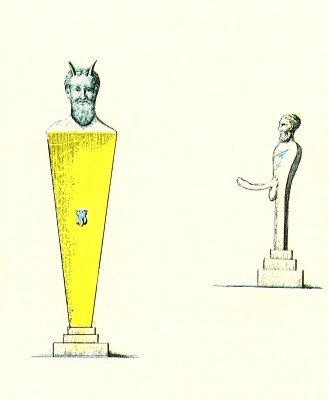
Plate XVII.
Of the size of the originals.
PLATE XVII.
FIGURE No. 1 represents the bust of a bearded Pan placed on a Hermes. In the centre of the latter is the Priapian sign. The head and the phallus are in bronze.
No. 2 is a grotesque figure, representing the same god.
It cannot be doubted that these little bronze figures were the household gods of some Roman family. A great many of them have been found, but as they differ but little from each other, it is useless to describe them all.
It may be remarked that the custom of worshipping unworthy divinities was not merely confined to the ancient world. Thus, for instance (if we may believe Garcilasso de la Vega), in Mexico there were temples consecrated to the gods of drunkenness, lechery, theft, &c. In fact, the Mexicans had their Bacchus, their Priapus, and their Mercury. This may serve as a confirmation of what we maintained in the Introduction to this book, that, as soon as man emerged from the savage state, his first religious promptings were directed towards the adoration of the mysterious powers which tend to the propagation of the human species. The Mexicans also worshipped the
the sun, and with all the nations of antiquity the sun was the principle of fire. Fire was looked upon as the principle of generation-the reproductive power, and the genitals as the attributes of the fertilising divinity of nature. All these, ideas were mixed together in one common belief, and gave rise to the same identical forms of worship.